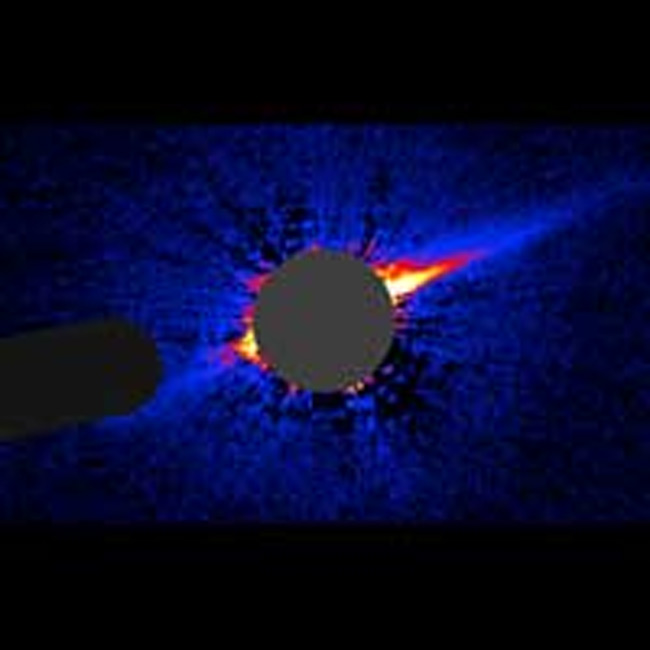Astronomers Find 'Blue Needle' in Space

An extremely lopsided debris disk around a distant star resembles a glowing, blue space needle, new observations reveal.
The finding, to be detailed in an upcoming issue of Astrophysical Journal Letters, could hint at hidden planets in the system or interactions with neighboring stars.
Astronomers think the dusty debris disk around the star HD 15115 is being affected by extrasolar planets in the system or nearby stars with very elliptical orbits. One possible culprit is HIP 12545, a star located only 10 light years away from HD 15115.
Unlike protoplanetary disks, from which planets form, debris disks are thought to be made up of material left over from planet production. Debris disks are similar to the Kuiper Belt in our solar system, the region beyond the orbit of Neptune that is populated with hundreds of icy, rocky objects (of which Pluto is one).
The disk around HD 15115 begins at about the same distance from its star that the Kuiper Belt does from our sun, but extends about 10 times further to at least 550 AU. One AU is equal to the distance between Earth and the sun.
Debris disks are thought to be replenished by dust created during collisions between its member objects. In the same way that Neptune’s gravity can affect Kuiper Belt Objects, planets close to HD 15115 could be affecting the shape of its debris disk.
According to one idea, Neptune originally formed between Saturn and Uranus, but was later booted out into the farther reaches of the solar system as the result of a gravitational dance between Saturn and Jupiter. “If such a planetary upheaval were occurring around HD 15115 at the present time, it could explain the highly asymmetric disk,” said study leader Paul Kalas of the University of California, Berkeley.
Get the Space.com Newsletter
Breaking space news, the latest updates on rocket launches, skywatching events and more!
Not only is the debris disk around HD 15115 more asymmetric than those observed around other stars, it also contains significantly less dust. “The missing mass is quite interesting,” Kalas said. “Perhaps the mechanism which perturbed the disk into its current asymmetric morphology also shaved away a significant fraction of the mass.”
It’s unknown whether the needle-shape of the debris disk is permanent, or whether it might flatten out into a more conventional shape later on. “The blue needle presents a host of new challenges for theorists,” Kalas said.
The needle-shaped debris disk was observed using NASA’s Hubble Space Telescope and the W.M. Keck Observatory in Hawaii.
- Top 10 Strangest Things in Space
- Top 10 Most Intriguing Extrasolar Planets
- Key to Planet Formation Found in Space Lint
Join our Space Forums to keep talking space on the latest missions, night sky and more! And if you have a news tip, correction or comment, let us know at: community@space.com.

Space.com is the premier source of space exploration, innovation and astronomy news, chronicling (and celebrating) humanity's ongoing expansion across the final frontier. Originally founded in 1999, Space.com is, and always has been, the passion of writers and editors who are space fans and also trained journalists. Our current news team consists of Editor-in-Chief Tariq Malik; Editor Hanneke Weitering, Senior Space Writer Mike Wall; Senior Writer Meghan Bartels; Senior Writer Chelsea Gohd, Senior Writer Tereza Pultarova and Staff Writer Alexander Cox, focusing on e-commerce. Senior Producer Steve Spaleta oversees our space videos, with Diana Whitcroft as our Social Media Editor.









